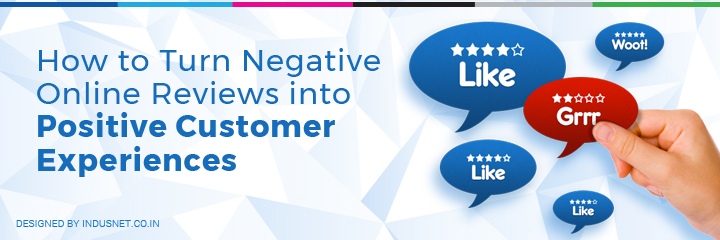
Businesses grapple with negative reviews every so often, that they are often left wondering how to effectively manage them. Those working in the digital marketing field will agree that negative reviews can actually help grow businesses, provide valuable insights into customer behavior, create new opportunities to build relationships, and improve brand reputation.
Before you begin to clench your teeth at the very mention of “negative review”, try to put your worries to rest and learn how to turn negative online reviews into positive customer experiences.
1. Acknowledge the reviewer
If there is anything that is more hurtful than feeling you’ve been wronged, it is not being acknowledged when you voice your concerns. When a customer leaves a negative review, it’s disrespectful and borderline-callous to simply ignore it. The first step one needs to take is to acknowledge the reviewer and their review. Merely knowing that you’ve been acknowledged feels like a balm to an aching muscle, and that can have deep implications to the positive customer experience you create.
2. Admit to the lapse, if any
Once you acknowledge the reviewer respectfully, admit to the lapse, if there is any. Consider the customer’s perspective, and try to walk in the reviewer’s shoes. What may seem like a minor lapse to you may be a huge deal for them and not acknowledging to the lapse that has occurred could be a bigger mistake than the one that has already occurred. If you feel you have been unfairly targeted, deliberate on why the customer might have chosen to make an effort to go ahead and type a review, negative or not. Most likely, there probably was a lapse that missed your attention.
3. Offer your side of the story
If there is a genuine reason for the lapse, explain your situation and narrate what actually went wrong. Owning up to one’s mistakes elevates one’s position in the eyes of the customer, rather than the contrary. However, make sure that your explanation does not come across as an excuse, as that diminishes your image. When you own up to the shortcoming, your customer will feel like they have been heard, and that has been given the importance they deserve to be.
4. Ask how you can make up for the oversight
Ask the customer what you can do to make up for the lapse that took place, and provides the reviewer with a few options to make them feel better. Being given options to undo the damage that’s been done is a great way to create a positive customer experience. If you start doing this often, you will begin to see a pattern in the kind of fixes that customers want, and you can straight away offer these fixes to make your customers happy when they write negative reviews.
For example, if you are an eCommerce business and have noticed that people repeatedly ask for shipping fee waivers when deliveries have been delayed, you can simply offer that as the default fix for shipping delays.
5. Explain the root cause, if any
This is not always possible but if you think there is a root cause to the problem that occurred, thank the customer for providing an opportunity to recognize its existence. Explain the circumstances under which the root cause of the problem has festered, and what action you plan to take to address it. Doing this makes your customer feel more confident about your business in general, and future customers who read your response to the negative review will appreciate your genuine approach towards doing business.
6. State the action you plan to take
Whether there was a root cause to the issue the customer stated, or it is a one-time lapse, make sure that you describe what action you will be taking to rectify the problem. Being as explicit as possible about your action plan imbibes a sense of honesty and dedication, and helps you gain respect from customers. Being vague or uttering cliches such as “we will do everything to fix the issue” can further infuriate an already irate customer.
7. Ask the reviewer how you can fix the issue
If you are unable to decide how you are going to fix an issue, ask the customer themselves what you can do to fix the issue. Most of the times, customers may simply acknowledge that they have been heard, and that’s more than enough for them, as mistakes are committed by everyone. Sometimes, customers may ask for minor favors, and very rarely, they may try to take advantage of you. However, that will not look bad on you.
8. Display proactiveness and empathy
Displaying empathy, or a genuine concern for the situation the customer finds themselves in, is more valuable than anything you will ever do to build positive customer experiences. Alongside empathy, you will also need to be proactive about fixing issues, making amends, and improve customer experiences. Most research studies point towards empathy and proactive behaviors enhancing customer experiences.
Your priority should be to build positive customer experiences, regardless of reviews
In short, regardless of the kind of online review you receive, your focus should be on building positive customer experiences. Begin to acknowledge the reviewer and their experiences, and work towards admitting to the lapses that might have occurred. Offer a genuine explanation, without it seeming like an excuse, and find out how you can fix the issue. Describe your situation, and explain how you will fix the problem, and ask the reviewer if there is anything else you can do to make up for their bad experiences. Underneath it all, ensure that you display empathy and proactiveness at all times.